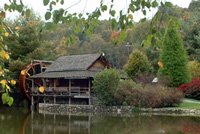 Tomatoes being produced in a simple, but profitable High Tunnel. Dr. Lewis Jett is an expert on these types of 'greenhouses'.
Tomatoes being produced in a simple, but profitable High Tunnel. Dr. Lewis Jett is an expert on these types of 'greenhouses'.This week's module covers the short Environmental Control Chapter in your textbook and a short review of plant biology. This course has no prerequisites, so this review needs to happen somewhere. Hopefully, it will be a review for some of you.
The greenhouse environment is a highly variable one. The level of environmental control is also quite variable. Ranging from the basic control provided by passively ventillating "high tunnels" to banks of computers managing everything from active cooling, heating, CO2, HAF fans, irrigation, and fertilization (like you might see in an operation the magnitude of Eurofresh Farms, Inc.) It is important to realize that what the greenhouse grower is striving to do is use the available environmental controls to maximize plant growth towards horticultural goals.
A high tunnel operator may strive to have organic late season tomatoes available. The growers customers may tolerate certain size variation and blemish issues in order to by an organic product locally. However, an organization like Eurofresh may use every environmental control manipulation at their disposal to produce a uniform high quality blemish free tomato at the same stage of ripeness. They may have a delivery wholesale target price and volume that they are contracted to meet. In both cases the individuals in charge of growing plants are manipulating the environment to achieve certain results in plant growth.
In order to understand fully the role that environmental control plays in plant development one must have a good foundation in plant biology. There are entire degrees offerred in plant biology, so the task of packaging this into a single module is relatively daunting. I have tried to boil down some of the most important factors from your reading, but in order to master this subject you will have to do substantially more reading in the future.
LEARNING OBJECTIVES
Differentiate between manual controls, step controllers, and automated environmental control
Discuss the advantage of integrated control
Briefly Describe the future of Model-based control
Be able to draw and label a typical plant cell
Learn the differences between meristematic and permanent tissues
ID the various parts of a leaf
ID the various parts of a complete flower
TERMS TO KNOW
manual controls
on/off switch
stepcontrollers
dedicated microprocessors
Integrated control
model-based control
photosynthates
chloroplasts
petiole
cells
carotenoids
cuticle
primary walls
vacuoles
stoma
cytoplasm
meristematic
guard cells
nucleus
cambial meristem
mesophyll
chromosomes
intercalary meristem
pallisade layer
genes
epidermis
stamens
mitochondria
root hairs
pistils
plastids
seedlings
calyx
chlorophyll
xylem
phloem
corrola
READING ASSIGNMENT and ACTIVE LEARNING EXERCISES
- Read Chapter 5. Environmental Control Systems in text. (pgs. 185-196)
- Watch Slide show on Environmental Controls. Watch two Eurofresh videos on structure and computers.
- Review Animation: Flower anatomy (200.498 Kb)
- Review Animation: Plant Transpiration Process (371.266 Kb)
- Review Animation: Water and nutrient uptake by roots (168.561 Kb)
- Review the components of the plant cell at Cells Alive. It will help you answer the study questions.
- If you need a basic review you can try this set of HTML pages on the plant Cell from Wellesley College.
- For an excellent review of leaf anatomy and leaf tissue organization review the following page and links at the Molecular Expressions Website.
- You should be able to label the basic parts of a plant cell, leaf cross section, and flower.
Short essay (answer in complete sentences)
- Compare and contrast on/off switches and step controllers. (10 pts).
- What are the advantages of integrated control using computers. Why do you think there are still so many growers who don't use integrated control? (20 pts)
- Watch the Eurofresh video on structure again. Summarize how computerized environmental control is so critical to their operation. How do you think computer use has made them more profitable. (15 pts)
- Briefly describe the evolution of environmental control in greenhouses. (15 pts)
- Describe where a "Speaking Plant fits into the evoloution of computer control (6 pts).
Fill in the blank (2 pts each)
- The aboveground light absorbing system of plants is made up of primarily_______________ and sometimes___________________.
- The basic units of which all plants and animals are made are ______________.
- The small bodies within the cell tha contain cholorphyll are called ______________.
- Large groups of cells that act together to perform the same function are known as ______________.
- Apical meristems are responsible for an increase in the _____________ of a stem.
- The epidermis of the root provides _____________ for the inner plant cells.
- A group of cells at the tip of a root is called the root ____________.
- Most of the absorption of water and nutrients takes place through the ___________.
- Water moves from the roots to the leaves through the vascular tissue called the ____________.
- The other vascular tissue is called the ______________.
- The point at which a plant will no longer recover from a lack of water is known as the _____________ point.
- The process of photosynthesis occurs mainly in the leaf ________________.
- A bud that grows in the angle between the petiole and the main stem is called an ___________ bud.
- Pores or openings in the leaf where gas exchange takes place from the outer air to the intercellular leaf spaces are called _____________.
- The male parts of the flower are a slender stalk called the _______________ and the enlarged part at the end called the ______________ where pollen grains are formed.
- The female parts of a flower are the ______________, ________________, and _______________.
- The showy, colorful parts of the poinsettia are called ___________


No comments:
Post a Comment